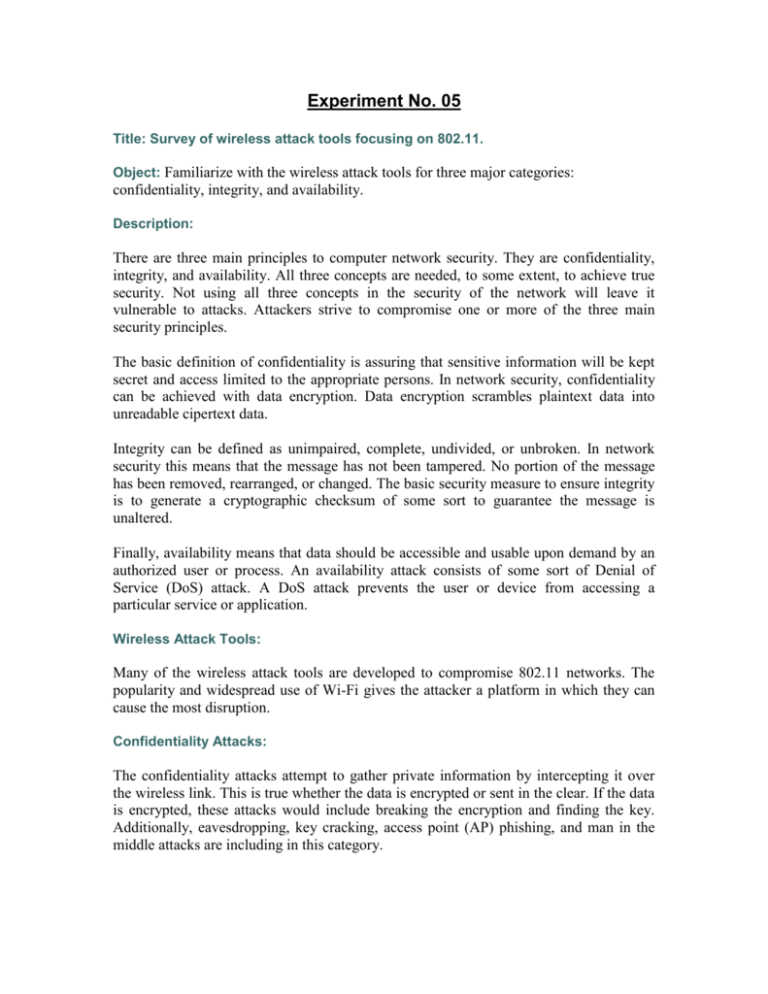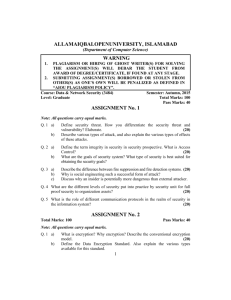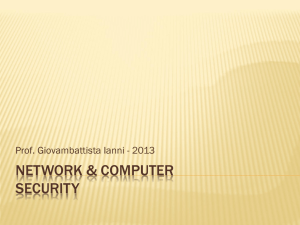View File
advertisement

Experiment No. 05 Title: Survey of wireless attack tools focusing on 802.11. Object: Familiarize with the wireless attack tools for three major categories: confidentiality, integrity, and availability. Description: There are three main principles to computer network security. They are confidentiality, integrity, and availability. All three concepts are needed, to some extent, to achieve true security. Not using all three concepts in the security of the network will leave it vulnerable to attacks. Attackers strive to compromise one or more of the three main security principles. The basic definition of confidentiality is assuring that sensitive information will be kept secret and access limited to the appropriate persons. In network security, confidentiality can be achieved with data encryption. Data encryption scrambles plaintext data into unreadable cipertext data. Integrity can be defined as unimpaired, complete, undivided, or unbroken. In network security this means that the message has not been tampered. No portion of the message has been removed, rearranged, or changed. The basic security measure to ensure integrity is to generate a cryptographic checksum of some sort to guarantee the message is unaltered. Finally, availability means that data should be accessible and usable upon demand by an authorized user or process. An availability attack consists of some sort of Denial of Service (DoS) attack. A DoS attack prevents the user or device from accessing a particular service or application. Wireless Attack Tools: Many of the wireless attack tools are developed to compromise 802.11 networks. The popularity and widespread use of Wi-Fi gives the attacker a platform in which they can cause the most disruption. Confidentiality Attacks: The confidentiality attacks attempt to gather private information by intercepting it over the wireless link. This is true whether the data is encrypted or sent in the clear. If the data is encrypted, these attacks would include breaking the encryption and finding the key. Additionally, eavesdropping, key cracking, access point (AP) phishing, and man in the middle attacks are including in this category. Eavesdropping is intercepting or sniffing the transmitted network traffic. This is capturing the bits transmitted on the physical layer, but many commercial programs will format the data into a user friendly way. This makes understanding the data much easier. If encryption is used, one will only see the encrypted data while sniffing. There are other tools available to crack certain encryption techniques. These tools also are considered confidentiality attack tools. Beyond simply capturing and displaying the packets from the physical layer, many of the sniffing programs have filters and plugins installed that have the ability to manipulate the data creating a man in the middle attack. For example, a sniffing program can have a filter running that will replace the https (secure website) with http (non-secure). As a result, the victim's authentication would appear in the clear across the physical layer. The eavesdropper would be able to see both the username and password for the login. Figure 1 - Man in the Middle Attack There are a variety of confidentiality attacks, but they all have one common goal - to gather the private information of a user. One or more of the attacks can be used. These include eavesdropping or sniffing, man in the middle attacks, and AP phishing. Confidentiality Attack Tools: For eavesdropping a commonly used tool is Wireshark, formally Ethereal. It is a basic sniffing program that will display all network traffic both wired and wireless. It is a multi-platform, multi-protocol analyzer with hundreds of protocols supported. It includes support for 802.11 and Bluetooth and also includes decryption support for many popular wireless security protocols including IPsec, Internet Security Association and Key Management Protocol (ISAKMP), Kerberos, Secure Sockets Layer, Wired Equivalent Privacy (WEP), and Wi-Fi Protected Access (WPA)/WPA2. Wireshark will display the captured data in an easy to read and easy to follow form. It also has many built in filters and the ability for the user to design their own filters. These filters can be used to only capture specific data such as a certain IP address, protocol, port number, etc. The sniffing programs work well for information that is sent in the clear. For encrypted information, an encryption key cracker is necessary. For 802.11, WPA2 is the latest wireless encryption standard that has not been broken yet. WPA and WEP are two previous encryption schemes with many tools available that will crack their encryption keys. AirSnort is a well known for WEP and AirCrack is an attack tools for WPA. Tools such as Hotspotter , APsniff , APhunter , and KNSGEM will scan for wireless AP beacon signals. Although they are not necessarily attack tools, they can be used to find the wireless APs. Type of Attack Encryption Cracker Tools Description AirSnort Brute force WEP cracker AirCrack WPA cracker Encryption Cracker Ettercap, dsniff, and Wireshark Packet sniffers with traffic analysis. These also include tools to break encryption. Packet sniffing Hotspotter, APsniff, APhunter, and KNSGEM Discovers WLANs by listening for AP locator beacon signals transmitted from APs. HermesAP Used to setup an Evil Twin and OpenAP rogue AP OpenWRT and HyperWRT Replacement Fake AP firmware so APs creation can be programmed to execute attacks. Integrity Attacks: The idea of an integrity attack is to alter the data while in transmission. Remember the integrity of the data means that it has not been altered in any way. This includes data deletion or addition, frame deletion or addition, or replay attacks. One integrity attack is frame injection. This is when an attacker will inject their own Ethernet frames in the middle of the transmission. This can be used in a variety of ways to attack the user. The user can be misled into accepting frames that it did not intend. All the major Internet browsers were vulnerable to a frame injection attack. This vulnerability has been fixed, but it does give an example on how this can be used as an attack. An attacker could inject frames into a transmission to display their content with the legitimate outer web page frames of another company. For example, a user would access their banking web page and it would look like their legitimate web page, but the attacker has injected Ethernet frames so that even though the web page looks legitimate it is not. When the user attempts to login all the login information can be recorder by the attacker. Similarly an attacker can delete or jam the data being transmitted. For example, an attacker could jam the wireless signal from reaching its intended target and also provide acknowledgments (ACKs) back to the source. The data would never reach the intended target, but the sender would have no idea, since it would see the ACKs. Data replay is yet another attack on data integrity. This involves the attacker capturing authentication information and saving it for later use. This can be used for 802.1X Extensible Authentication Protocol (EAP) or for 802.1X Remote Authentication Dial-In User Service (RADIUS) authentications. Once the attacker has captured and saved the authentication information, it will monitor the traffic for another authentication. Then it will inject those frames instead of the legitimate authentication frames and essentially gaining access to a system. Tools Description Type of Attack Airpwn Allows for generic 802.11 packet injection 802.11 packet injection File2air Allow the specified 802.11 file be used as replay packet payload. AirJack and Simple- Allows previously 802.11 captured packets to replay be injected back into replay the network. Availability Attacks: Availability attacks are most simply described as DoS attacks. DoS focuses on attacking a specific part of the network so that it is unreachable. Network availability means that any point the network is able to provide the requested information to the authorized user. DoS attacks prevent this information from reaching the user. There are several types of DoS attacks; one is flooding. Flooding is overloading the network with a certain type of packet so that the wireless AP is busy serving all the flooding packets that it cannot serve any legitimate packets. For example, an 802.11 beacon flood is where thousands of illegitimate beacons are generate to make it difficult for individual machine to find the legitimate AP. Another is an 802.11 authentication flood where thousands of authentications are sent from random Media Access Control (MAC) addresses filling up the AP's authentication table and making it hard for a legitimate user to gain access. This gives a small example of the types of flooding attacks someone could execute on a wireless network. Figure 2 - Beacon Flooding The list of attack tools for availability is similar to that of integrity. Many of the same tools can be used because of the similarity in the attacks. Many of the flooding attacks can be accomplished by using the injection attack tools on top of the flooding tools. To execute an authentication flooding attack, you could use frame injection to inject many authentication frames from different MAC addresses. This will fill up the authentication table of the AP and make it difficult for a legitimate user to connect. There are, however, some specific tools available to launch these attacks that are separate from the integrity attack tools. FakeAP generates thousands of 802.11 APs or more specifically it generates thousands of 802.11 beacon signals that can be used for the beacon signal flooding attack. There are a variety of availability attacks. All of them implement a DoS attack of some sort whether it is radio frequency (RF) jamming or network flooding. There also are many different flooding attacks with just a few examples given here. Flooding attacks promote the vulnerabilities of the protocols. Type of Attack Tools Description FakeAP Generate thousands Flooding of 802.11 beacon DoS signals. Void11 Can be used to execute deauthenticate, authenticate, and association flooding attack. Many commercial tools available Jams the RF signal so that it cannot be RF distinguished by a jamming legitimate device. Flooding DoS Lab Task: Read the manual carefully and be prepare for the viva of this manual.



![Systems Assurance [Opens in New Window]](http://s3.studylib.net/store/data/007522633_2-e364c8f93e26286779d02c826b323ed6-300x300.png)


